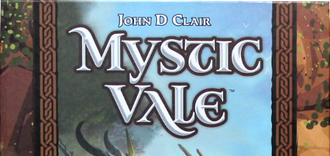
I got to spend an awesome weekend of gaming in Texas at Gamer Nation Con V. In addition to meeting so many people that I’ve only known online, I got introduced to several new board games. One of them was Mystic Vale.
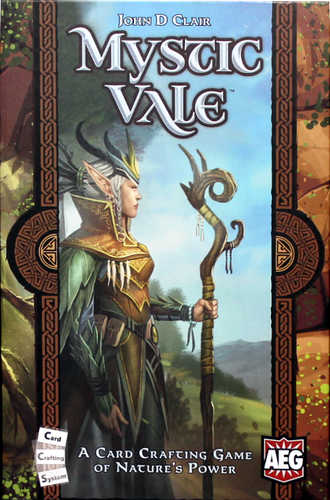
Mystic Vale, by John D. Clair and Alderac Entertainment Group is an interesting take on the standard deck building game. In this game, two to four players take on the role of a druidic clan attempting to cleanse the Valley of Life from a curse that has been placed upon it. You do this through planting fields and using the results of your harvest to cultivate and heal the land as well as rescue the spirits that call it home. Through the game, you accrue victory points, and the player with the most victory points at the end is the winner.
This game uses what is called the “card crafting system.” Instead of adding cards to your deck, you have the same twenty cards in your deck, which are all placed in sleeves. As you play the game, you “advancement” these cards, which then modifies them each time they are subsequently played. The advancement cards are all printed on transparent material, and are “sleeved” onto a card you have in play when you but that advancement. Each of your cards can have three advancements, but several of them already come with one advancement on them. But to add a further tactical element, you cannot place an advancement card just anywhere on your card – they occupy either the top, middle, or bottom of the card. If that spot on your field card is occupied by an advancement, it cannot be changed. This means that the card you really want to purchase cannot be purchased by you because you don’t have a card that can take the advancement.
The game uses a “push” mechanic. Several of your deck cards have a “decay” symbol on them, representing the curse that has been placed on the Valley of Life. At the end of each of your turns, you prepare your next hand of cards, drawing from your deck until you have three of these decay symbols showing, which includes what you have in play, along with the card that you have “on-deck.” This means that the size of your hand can and will fluctuate from turn to turn. You may have as few as two cards in play, or you could get a good run. Once the advancements started coming in, it wasn’t strange for us to have as many as eight cards in play on a given turn. However, if you want to try to get more resources to spend, you can choose to play your on-deck card into your field, adding it to your resources. You then reveal the next card of your deck as your next on-deck card. You can continue to do this as many times as you want until you are satisfied with your field and choose to move to the harvest phase. However, if you run the risk of revealing a fourth decay symbol and spoiling your field – if this happens, you forfeit your harvest phase, and discard your hand and prepare for your next turn.
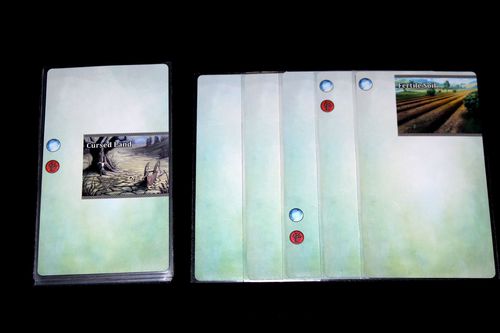
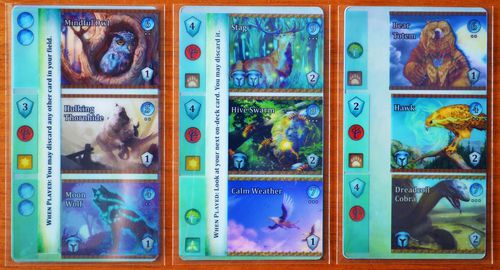
Each of your cards has a chance of producing various resources, the most common being mana. Mana is what you spend to buy advancements for your cards. Some advancements produce victory points when they come into play and/or provide additional victory points at the end of the game. Some advancement cards produce a special “growth” symbol that cancels one decay symbol. Certain advancements also have special rules that happen when they come into play or during certain phases of play. A certain few of these abilities are constant, which allow them to be in play even when they are in your discard pile or on-deck ready to be played. Finally, certain advancements also produce one or more types of spirit symbols, which can be spent to purchase vale cards, another set of cards which provide powerful in game effects as well as additional victory points at the end of the game. Once the final victory point has been taken from the initial pool (which is determined at the beginning by the number of players), the round finishes play, with additional victory points being scored as normal. Victory points are then counted and totaled. The player with the most victory points is the winner.
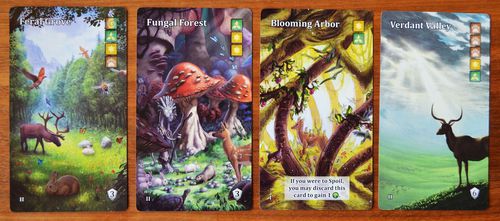
I really, really enjoyed this game. At the time of writing this article, I have a copy of the game arriving tomorrow (thanks Amazon Prime) and I can’t wait to introduce it to some people up here. Learning the game is a little strange. I played this with two other people and we stumbled our way through the first turn and a half before everything seemed to click into place, but once it did, we all enjoyed it a lot. The card advancement system provides a very unique tactic to the game where you have to take into account the rest of your deck – you can pile powerful advancements on to one card, but then you leave other cards in your deck that produce no resources. Then there is the fact that you may not have any cards in play that can take an advancement that you really want, because the advancement is in a spot that is occupied in all of the cards in your field. I can’t wait to see what more I can learn from additional plays of the game.
Mystic Vale retails for $44.99 and there are currently 10 expansions for the game. It states a 45 minute playing time and is suitable for players of 14 and older. Younger players might not understand some of the concepts, but as always, your mileage and children may vary. If it is your first time playing the game, budget more time – we played for about an hour at the convention and ended up playing our last turn early after an hour of game time because I needed to get to another event. Most of that was reading the rulebook and the first few turns. After that, things moved at a fair clip. The fact that you set up your field when the next player is going really helps to keep things from slowing down.
